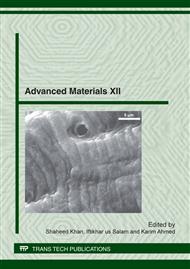p.500
p.507
p.513
p.520
p.527
p.532
p.540
p.547
p.554
Synthesis and AC Electrical Characterization of Co Doped Bismuth Manganite Nanoparticles
Abstract:
Multiferroic bismuth manganites (BiMnO3) possess both ferromagnetic and ferroelectric properties. Their electrical properties can be controlled by doping for useful applications. In this work single-phase cobalt doped bismuth manganite nanoparticles having general formula BiMn1-xCoxO3 (x=0, 0.2, 0.4, 0.6) were synthesized by co-precipitation method. Structural properties like lattice parameters and crystallite size of samples were determined by the data obtained by X-rays diffraction. The dielectric constant (ε) and dielectric loss tangent (tanδ) of samples were investigated as a function of frequency from 20Hz-3MHz using ac measurement data. For all the compositions dielectric constant was decreased with increasing frequency, however it increased with the increase in cobalt content. However cobalt addition causes a decrease in loss tangent as compared to pure BiMnO3 composition. The origin of this behavior is discussed in terms of Maxwell-Wagner and Koops model. Substitution of Mn with Co, in BiMnO3-based compounds is supposed to cause better properties in terms of tangent loss.
Info:
Periodical:
Pages:
527-531
Citation:
Online since:
May 2012
Keywords:
Price:
Сopyright:
© 2012 Trans Tech Publications Ltd. All Rights Reserved
Share:
Citation:


